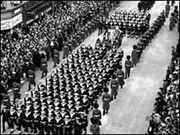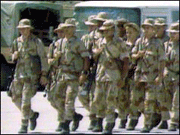January 30
[ 2007-01-30 09:38 ]
 |
| Thousands of people line
the route of the funeral procession |
| 1965: Last farewell to Churchill |
England have
Thousands of people have paid their last respects to Britain's greatest
wartime leader Sir Winston Churchill who was buried today after a full
state funeral.
Silent crowds lined the streets to watch the gun carriage bearing Sir
Winston's coffin leave Westminster Hall as Big Ben struck 0945. The
procession travelled slowly through central London to St Paul's cathedral
for the funeral service.
Sir Winston died six days ago, following a stroke earlier in the month
from which he never regained consciousness.
A total of 321,360 people filed past the catafalque during the three days of
lying-in-state.
Today, millions around the world watched the funeral procession at home
and abroad as television pictures were beamed from 40 BBC cameras placed
along the route.
The mourners were led by Sir Winston's wife, Lady Clementine Churchill,
his son Randolph and daughters Mary Soames and Lady Sarah Audley. The
Queen and other members of the royal family, the Prime Minister, Harold
Wilson, and representatives of 112 countries packed into the cathedral for
the service.
The funeral cortege was accompanied by a 19-gun salute and an RAF
fly-past as it began the journey to Sir Winston's final resting place. At
Tower Hill, the coffin was piped aboard the launch Havengore for the
voyage up the Thames.
From Waterloo, it was placed onto a train drawn by a Battle of Britain
locomotive named Winston Churchill. Thousands gathered to pay tribute at
wayside stations. At many football matches a two-minute silence was
observed.
Sir Winston was finally laid to rest in the Oxfordshire parish
churchyard of Bladon, close to Blenheim Palace where he was born 90 years
before, with only family members present. |
|
|
|
 |
| US Marines are the first
of the Allies to suffer casualties in this
war |
|
1991: US Marines killed at Al
Khafji | Artificially 1969:
The Iraqi troops
have seized control of a town inside the Saudi Arabian border after a
fierce battle in which both sides suffered casualties.
The Allies destroyed at least 24 Iraqi tanks in the fight for control
of Al Khafji. Twelve American marines lost their lives - the first Allied
casualties on land since Desert Storm began 14 days ago. There were no
British soldiers involved in the fighting.
The attack on Al Khafji came as a surprise and the US military
commander, General Norman Schwarzkopf, said it showed the Iraqis have
"plenty more fight in them".
He was speaking to reporters as the
first detailed assessment of the Allies' progress in the war was made
public.
General Schwarzkopf said the Allies now have total air supremacy.
He said: "The Iraqis have abandoned centralised control of air defence
within Iraq and Kuwait, a very important point."
Ammunition dumps have been destroyed and the main supply route between
Baghdad and Kuwait disrupted.
Saddam Hussein's elite troops, the Republican Guard, have come under
sustained aerial bombardment
At sea, 46 Iraqi ships have now been sunk. More warplanes and ships
have taken refuge in Iran.
General Schwarzkopf said: "The simple fact of the matter is that now
every time an Iraqi airplane takes off the ground it is running away, as a
result [we] have now claimed air supremacy."
Reports from the northern Gulf suggest the Iraqis have begun dumping
oil into the sea at Mina Al Bakr.
Iraqi shelling has already created a slick measuring 50 miles long by
12 miles wide (80km by 19km) which could seriously hamper any seaborne
defence of Kuwait.
In his state of the union address to the American people following news
of the first land battle, President George Bush praised the troops serving
in the Gulf.
He said, "There is no-one more devoted more committed to the hard work
of freedom than every soldier and sailor, every marine and coastguardsman,
every man and woman now serving in the Persian Gulf." |
|
| Vocabulary:
|
| |
|
catafalque : a decorated bier on which a coffin rests
in state during a
funeral(灵柩车)
|
|